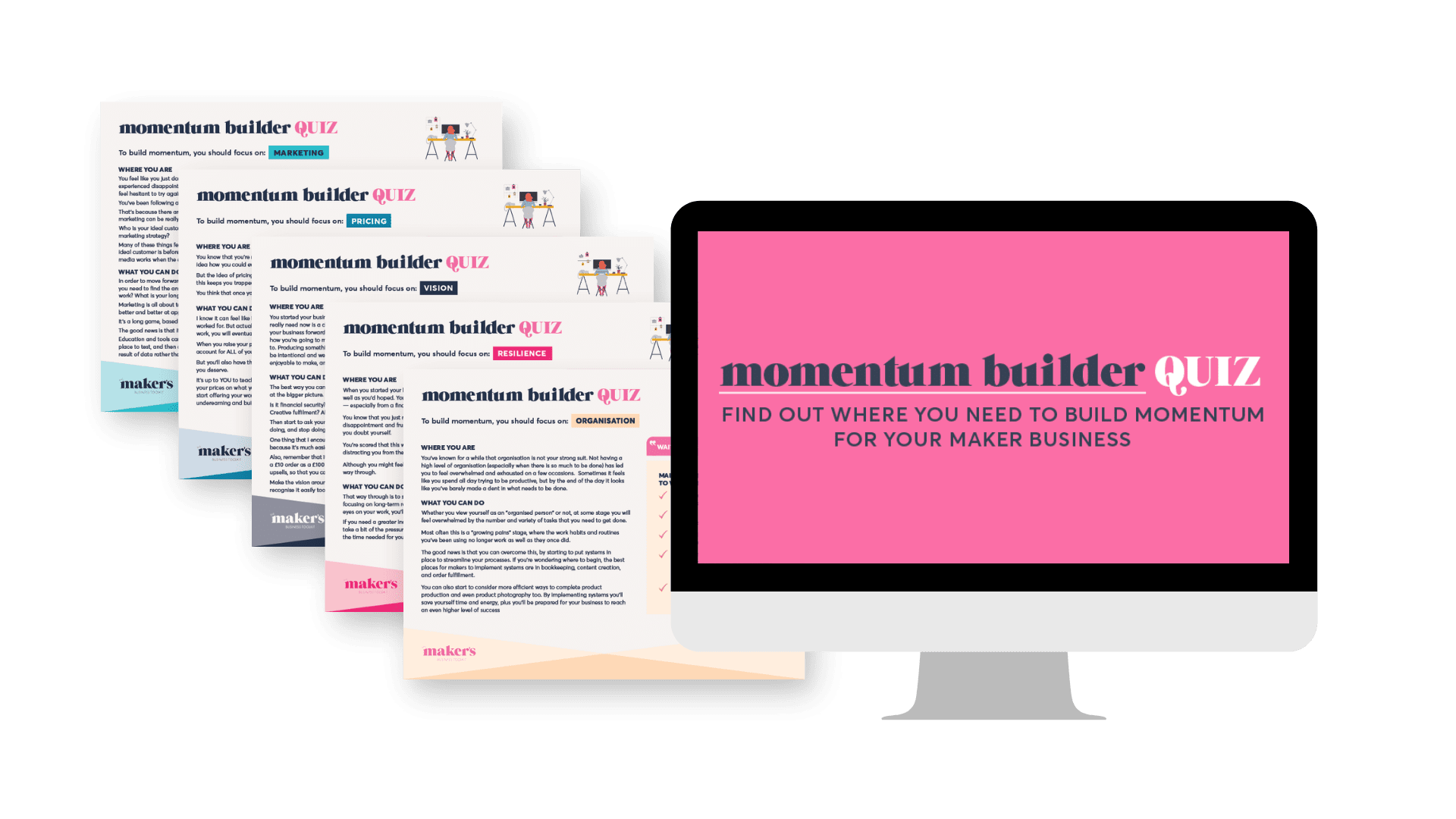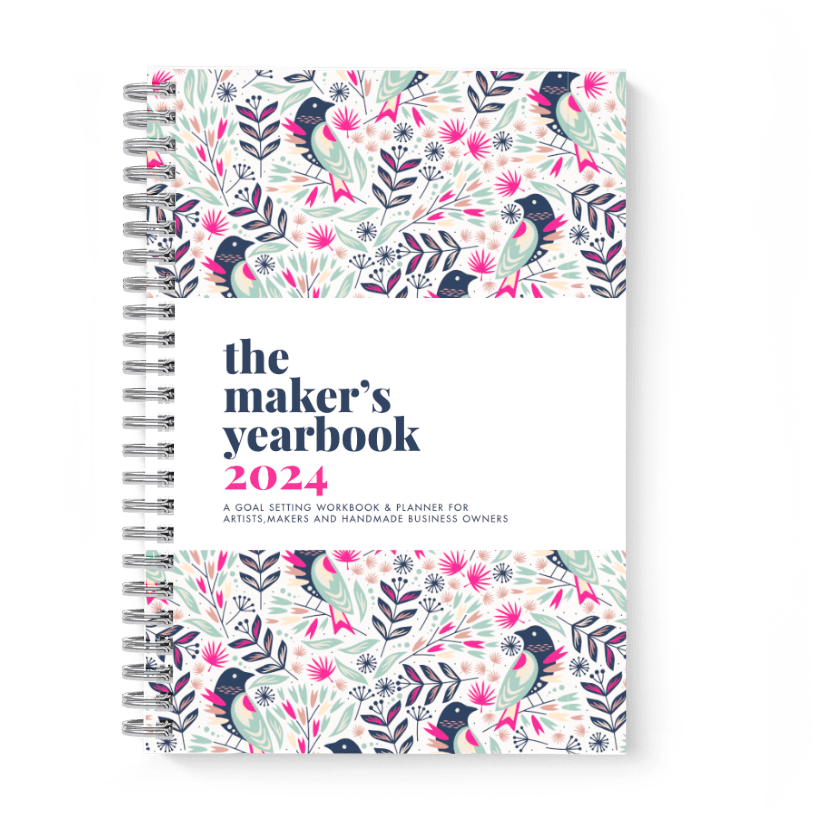Are you a people pleaser? Do you hate saying no to your customers? Do you hate saying no to anyone?
I think a lot of makers, especially those in the first few years of business, find it really hard to set boundaries with customers.
When you’re not making the level of sales you want or need to make, it can be really hard to say no, or even just to give yourself permission not to be immediately available at all times.
Plus, quite honestly, so many of us have been brought up to equate saying no with being difficult or selfish or just not being a good person.
But, boundaries are healthy and necessary if you don’t want your maker business to become something that makes you miserable.
When we say yes to something, we’re saying no to something else. Always.
And most of the time that’s fine. That’s how it’s supposed to be.
We’re saying yes to working on this commission and saying no to doomscrolling and worrying about sales.
But what about when saying yes means saying no to something that really matters to us?
Or when saying yes now means saying no to our long term success?
Saying yes to last minute revisions on a commission may mean saying no to family time, or to making a profit on the project.
Saying yes to discount requests may mean struggling to afford new materials or to pay your business expenses.
Saying yes to a last minute Christmas order from a stockist may mean saying no to sleep, or to higher margin sales from your own website, or to peaceful preparations for your own Christmas?
In each of these cases you COULD do it, it might help your business in the short term to do it, and it’s definitely easier to say yes, but doing it hurts your long term plans and often your wellbeing too.
Those are the most difficult times to say no.
It feels like you’re being awkward and that you’re damaging your business and possibly losing sales.
But what you’re really doing is protecting your future, your energy, your finances, and your wellbeing.
You’re considering whether you could say yes, not just in terms of whether it’s actually possible, but also in terms of what will have to be sacrificed.
A lot of the time we say yes to these requests because we don’t know how to say no.
But the easiest way to say no to a request is to set your boundaries in such a way that you don’t even have to.
Here’s my three step strategy for setting boundaries that save you time
and worry
1️⃣ Set expectations
2️⃣ Communicate that you really do mean it
3️⃣ Clarify and explain when someone tries to push the boundary
But what does this actually look like in practice?
Let’s take this system and look at a real example that causes a lot of stress for makers – responding to incoming queries from customers.
This is an area where a lot of us feel quite overwhelmed. You might have questions coming via email, Facebook messenger, Instagram direct messages, Whatsapp messages, messages on Etsy and other marketplace platforms, comments in your Facebook Group, comments on your posts.
It can be stressful to ensure that nothing gets missed and it’s easy to end up in a circle going from platform to platform to platform, checking and responding to messages as soon as they come in.
There are be times when it’s important to be available to respond to incoming messages right away. Maybe in the last few hours of a promotion, or the last day before Christmas orders close, or when you’re launching a new product.
But the rest of time, you just don’t need to respond to everyone immediately, and you shouldn’t be constantly plugged in to inboxes and notifications that pull you away from your important work.
So having strong boundaries around customer service response times can be really helpful, not only for minimising interruptions, but also for your own wellbeing.
Let’s look at how it could work
Set expectations
Before you can really set expectations for your customers around how long they might need to wait to get a reply to a question, you need to have an internal company policy around this.
You might be a company of 1 but it’s still important to know what the policy is, because it makes it so much easier to communicate to other people when you’re clear on it yourself.
It also holds you accountable when you might be letting things slip, and gives you permission to not respond immediately when you’re stressed and busy.
If you can, I would recommend a centralised approach where you ask that all customer queries come through one channel (usually email) and you redirect people who contact you in other ways to get in touch via email, or whatever channel you have chosen.
For me, email works best because it’s easy for things to get lost or hidden on social media. I prefer to have all the queries in a place where I’m sure that everything is visible to me and stays visible to me until it is dealt with.
Once you’ve decided on your policy, make it really easy for anyone who needs help to find out when they’ll hear back from you.
An autoresponder on your emails can be a good way of setting expectations around how long it will take to get a reply to a question. Your message should let people know that you’ve received their message and tell them your working hours and expected response time.
You can also put this information on your email signature, on your FAQ pages, and in autoresponders on your social media inboxes.
Communicate that you really do mean it.
This means that you reinforce the boundaries you’ve put in place with your behaviour.
In other words, you stick to what you said you were going to do.
So if your autoresponder says you don’t work weekends, then don’t reply to messages on weekends, except in exceptional circumstances.
If you want to get your customer service emails done at the weekend so that they don’t build up, or you want to do some preparation for the week ahead then draft your responses to the emails, but don’t send them until Monday.
Why does this matter?
Because if you don’t stick to your own boundary, why should anyone else believe it’s important or that it applies to them?
That puts you back in a situation where people don’t know what to expect from you, so they create their own expectations around when you might reply, which can lead to complaints.
So just as you shouldn’t train people to expect an answer outside of your working hours and response turnaround time, you also shouldn’t exceed the promised turnaround time.
So if you tell people that you’ll respond within 1 working day then you need to make sure that always happens.
And if you want people to always contact you via email, again you need to use your behaviour to communicate that you mean it.
That means that you don’t answer questions in your DMs, except in unusual circumstances. Instead, any time you get a customer service question you will send that person an automated response that asks them to contact your support inbox.
This can often feel like being awkward. You’re in the social media inbox, you could answer the message there and then and you’re only going to have to respond to the same question in the email inbox later.
But it’s about training your customers to understand that when you say something, you mean it, and creating a system that is better for everyone because nothing gets missed. Plus your customers understand that they can trust your word, which is important when you’re dealing with tricky customer service issues like lost parcels.
Clarify and explain when someone tries to push the boundary
No matter how clearly you communicate your timescale for responding to customer messages, some people will expect an immediate response.
They might complain and become more aggressive in their email messages. They might DM you on social media and then maybe even comment on your posts, complaining that they haven’t had a response.
This can definitely make us uncomfortable and it’s easy to just let our boundaries go, just this one time, to get this person off our social media. This is, of course, why they do it.
In situations like this, it’s about clarifying the boundary (in case they didn’t realise) and explaining when and how they’re going to hear back from you.
For those people who send multiple emails over a 24 hours period, or over a weekend, I think it’s reasonable to add a brief reminder about your target response times to your email.
Try to make this firm and clear, rather than defensive, even if you’re feeling annoyed.
Something like this:
Hello {first name}
Thank you for your patience. We are a small business and aim to respond to all queries within 1
working day, although we’re often a lot quicker.
Your query was received over the weekend so we were closed, but I’d be happy to help you with it
now.
For the people who send direct messages on social media, having an automated response that reiterates your working hours and expected response times can reset expectations and prevent you from having to step in outside of those hours.
It also has the effect of keeping Facebook or Instagram happy that you are responding to people within a reasonable timeframe. Remember, you don’t need to resolve the issue within the response time. It’s just about letting people know what is going to happen next.
For the people who comment publicly on your posts or post on your profile, you should definitely reply because it allows other customers on your profile to see that you are responsive and that this person just misunderstood the working hours and response times.
If someone does this over a weekend, it’s your choice as to whether you reply immediately or whether you wait until Monday.
It can make you feel very vulnerable when someone is complaining very publicly, so it might make more sense to send a quick reply straight away, rather than trying to leave it and spending the rest of the weekend worrying about it.
This should be something you write in advance and keep as a saved response in a notes app on your phone, or somewhere else you can access it when you’re not at your desk.
I often prefer to use “we” in this kind of situation, rather than “I” because it feels softer and less direct. There’s no right or wrong choice here so just do what feels best for you.
A sample reply might be:
“Hey {first name}. The best way to get support for your query is by emailing {email address}
If you’ve already emailed us then we’ll get back to you as soon as we can. Our support hours are Monday to Friday 9am to 5pm and we usually respond to all emails within 1 working day, and often sooner. Thanks so much for your patience”.
This reply is as much for everyone else seeing the post as it is for the person who has commented. It shows them that you’re not actually ignoring the commenter, you’re just asking them to be patient (and allow you to have some time off).
It also allows you to regain control of the situation so that you can enjoy the rest of your weekend without worrying about complaints on your posts.
Boundaries make saying no a lot easier
In this post, we’ve applied a three step strategy for enforcing boundaries to managing your communications with customers.
But we could just as easily apply this to situations like:
➡️ Managing attendance and no shows at workshops
➡️ Managing revisions for commissions
➡️ Responding to refund requests
➡️ Handling last minute requests from retailers or show organisers
Boundaries give us a simple framework for saying no and feeling good about it. Or at least okay about it.
And it can end up being a really positive experience for our customers too as the act of setting out our boundaries can often help us to communicate and be clear about important information that they need in order to consider making a purchase.
Having sensible policies that are clear and that we stick to helps our customers to feel confident that they will have a good experience when they make a purchase.








